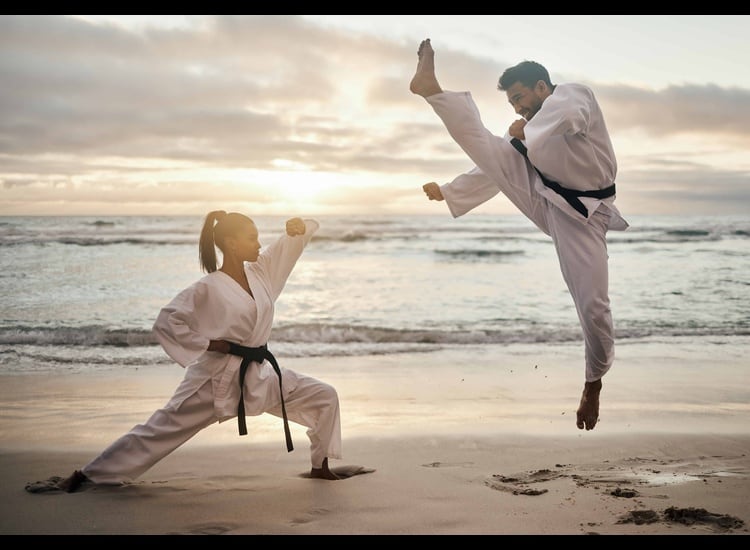
Reaping the benefits of studying the martial arts requires a significant investment of time, energy and discipline. Regular practice of techniques is a requisite to gaining mastery in any form of the martial arts disciplines. Similar to learning other hobbies, training in the martial arts takes dedication.
Many practitioners of the martial arts take classes, and the learning experience in group settings is unmatched. Studying the discipline empowers students. Not only are students’ bodies conditioned, but so are their minds. Trainees learn skills that may be applied throughout their lifetimes.
Martial Arts Training
Watching an experienced martial artist engage in high-flying kicks, sophisticated sweeps or timely punches is undeniably impressive. Despite the mind-blowing techniques veteran martial arts practitioners use, certain martial arts disciplines are less intimidating to learn and easy to put into practice.
Acquiring skills in the martial arts can be conveniently done in one’s home. Online instructional videos offer a few of the same benefits as in-person classes—but online courses lack the important element of personalized instruction. Still, students can pick up easy-to-learn self-defense techniques.
Students who already possess limber and flexible physiques will find it easier to learn the martial arts. Successful martial artists are highly disciplined. Needless to say, martial arts trainees with existing self-discipline will grasp many of the various forms with ease.
Easiest Martial Arts to Learn
Check out the following martial arts disciplines that are easy to learn:
1. Karate
Karate is a diverse martial arts discipline that may be learned from any of three angles: as a form of self-defense, or as an art. Children and older people are drawn to karate, given that it is an extremely safe form of the martial arts.
Karate is popular with a wide range of age groups. The discipline still requires correct technique in order to be successfully executed. Theory is important, as is practice. Martial artists consider karate to be highly adaptable, easy to learn and, when done correctly, very effective as a form of self-defense.Techniques integral to karate include punching, kicking and sparring. In order to build stamina through sparring, a willing partner is necessary. Sparring helps students learn to transition through various karate moves.
Karate relies on proper balance, speed, and power. Several basic stances that are important to the practice of karate can be readily learned. These include the ready stance, front stance, walking stance and back stance. Stances simply involve positioning the feet and being ready to engage.
2. Basic Boxing
New martial arts students might explore basic boxing. The sport may be practiced alone and without the need of a partner. As students progress, they learn to become agile; trainees also come to realize their strength potential. Boxing requires only gloves, but practice can be accomplished without gear.
Like karate, basic boxing involves stances. The fighting stance is the primary stance in boxing. All power stems from a proper fighting stance. A good stance is also important in maintaining balance when throwing basic punches. As practitioners continue training, skill and experience become teachers.
3. Muay Thai
The entire body is a weapon in the martial art known as Muay Thai. Learning Muay Thai gives even beginner students valuable self-defense skills. Sparring has a dominant place in this martial art, making having a willing partner a necessity. Still, some elements may be learned alone.
Equipment the trainee requires include boxing gloves, a punching bag and shin guards designed specifically for engaging in the practice of Muay Thai. Techniques integral to Muay Thai are knee strikes, punches and kicks. These moves become easier to implement as the student practices.
4. Jiu-Jitsu
Jiu-Jitsu is a powerful form of martial arts that is designed so a smaller fighter has ample physical resources to successfully defend against a larger opponent. If Jiu-Jitsu is practiced alone, reactions may be difficult to anticipate. A partner helps the student realize whether or not good technique is used.
In Brazilian Jiu-Jitsu, trainees use ground-fighting techniques and stand-up maneuvers. Students apply chokes (such as the guillotine choke or triangle choke), joint-lock manipulations and single- and double-leg takedowns to defeat the bigger challenger. Practicing these specific techniques requires a partner.
5. Krav Maga
Krav Maga is a blend of Muay Thai, boxing, judo, grappling and fight training. The driving force behind Krav Maga is centered around the goal of delivering enough damage to the adversary so the fight may be quickly finished.Individuals who train at home require equipment, such as boxing gloves, a heavy bag and space to hang it in as well as Muay Thai shin guards. Practicing Krav Maga helps the student acquire valuable self-defense skills.Programs teaching Krav Maga focus on executing a proper fighting stance, learning punches, how to escape headlocks, how to fall with limited injury if knocked down and best ways to defend against chokes, bear hugs, and overpowering headlocks.
Comments (0)